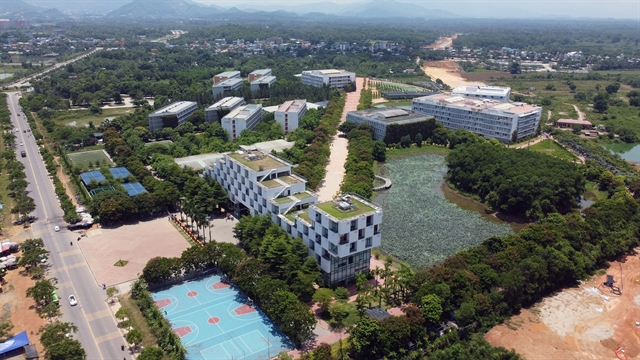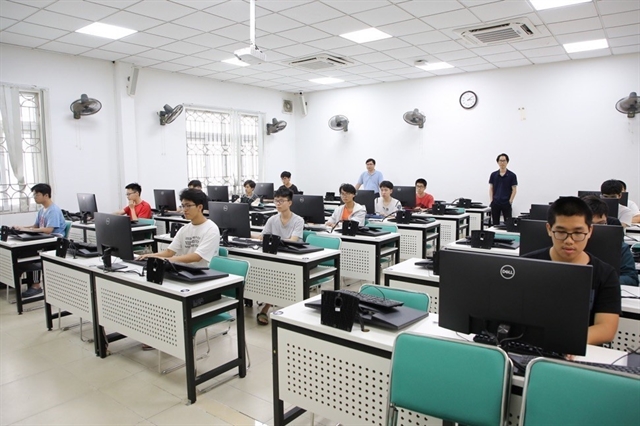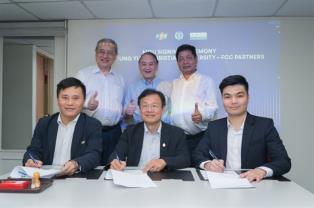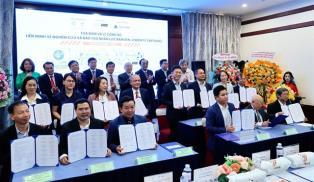Hà Nội is stepping up efforts to advance science, technology and innovation to get itself prepared for the global semiconductor supply chain.

HÀ NỘI — Hà Nội is accelerating efforts to advance science, technology and innovation as it positions itself to join the global semiconductor supply chain.
The municipal Department of Science and Technology held a seminar on October 22 titled 'Positioning for participation in the global semiconductor supply chain: criteria, leading powers, Việt Nam’s pathway and Hà Nội’s vision,' with Deputy Chairman of the Hà Nội People’s Committee Trương Việt Dũng attending to discuss solutions for developing the capital city’s chip-making industry.
Director of the municipal Department of Science and Technology Trần Anh Tuấn said that Hà Nội has positioned itself as a national leader in science, technology and innovation and is ready to take on challenges to help Việt Nam move up the global technology value chain.
Hà Nội has been striving to master core technologies, including semiconductors and chips, to generate higher added value and drive the capital city’s growth, in line with the Politburo’s Resolution 57/NQ-TW dated December 22, 2024 on breakthroughs in science, technology, innovation and national digital transformation.
“It is necessary for Hà Nội to identify the positioning and choose the right pathway, given the vast semiconductor industry with multiple stages and complex value chains,” he said.
Experts at the event said that Hà Nội has significant advantages to promote the development of the semiconductor industry.
Hà Nội holds a strategic position in Việt Nam’s semiconductor strategy with the Hoà Lạc Hi-Tech Park, which aims to help turn the capital city into a hub for semiconductor assembly, packaging and testing (APT).
The city aims to develop Hoà Lạc Hi-Tech Park into the Silicon Valley of Việt Nam, focusing on APT, artificial intelligence (AI) research and development and chip design. By 2030, the park is expected to attract US$10 billion in investment, 30 per cent of which is anticipated to come from foreign direct investment (FDI) semiconductor companies.
Home to major universities including Việt Nam National University (VNU), Hà Nội University of Science and Technology (HUST) and FPT University, Hà Nội also leads in semiconductor workforce training. The National Semiconductor Training Centre under VNU plans to train 10,000 engineers specialising in chip design and manufacturing by 2030.
Alongside these advantages, Hà Nội faces significant challenges.
Director of the ASIAN Institute of Advanced Technology Nông Đức Kế said that the decisive factor in the semiconductor race for Hà Nội in particular and Việt Nam in general is to clearly define its position in the global value chain.
Stressing that the semiconductor industry is of enormous scale and requires advanced technologies as well as massive investment, Kế said that developing the sector is a task far beyond the capacity of any single locality.
“Success will require a coordinated nationwide effort and a national strategy driven by dare-to-do spirit,” he said.
He added that any wrong positioning can be costly, requiring the right direction from the start. Entry barriers to the semiconductor industry are extremely high, with only some 18 countries and territories currently playing major roles. “Every step must be planned with caution and with a long-term vision,” he said.
According to chairman of IP Group Ngô Đắc Thuần, Hà Nội needs a comprehensive approach to develop a semiconductor hub, including human resource training, intellectual property rights, high-tech product development, incubation, technology transfer, start-up support and prototyping services

Focusing solely on training chip design engineers is not enough, and resources need to be allocated appropriately — for example, 30 per cent for chip design, 40 per cent for chip production and 30 per cent for packaging and testing, he said.
At the same time, it is vital to foster creative thinking, innovation, design-oriented mindsets, R&D capacity and intellectual property management across the entire semiconductor supply chain, he added.
He stressed that Hà Nội should encourage the development of supporting industries by attracting both foreign and domestic investment.
According to Dũng, developing the semiconductor industry is a strategic mission that will play a pioneering role in helping the capital city achieve double-digit economic growth.
Hà Nội has become increasingly innovative in recent years, topping the country in terms of innovation and digital transformation, he added.
On the goal of developing two national semiconductor hubs, Dũng said the city is working on a comprehensive strategy covering policymaking, human resource training and infrastructure development.
Hà Nội has also committed to investing heavily in science and technology, pledging 4 per cent of its budget expenditure — above the national average of 3 per cent.
The city will support existing private innovation hubs and integrate them into the broader innovation ecosystem, following a win-win approach inspired by successful models such as Seoul in the Republic of Korea and BLOCK71 in Singapore, he said.
A regulatory sandbox mechanism will also be introduced to accelerate the growth of emerging sectors, including semiconductors, he added. — VNS




